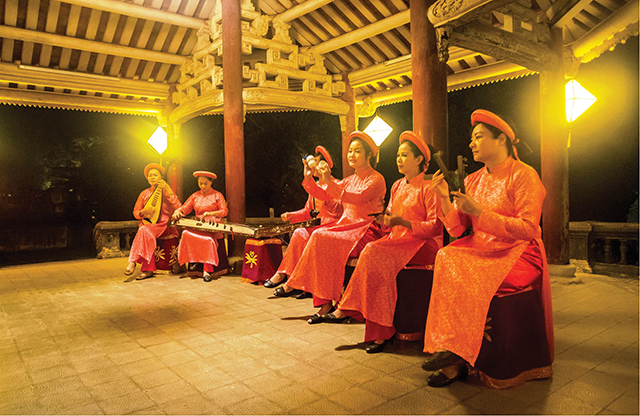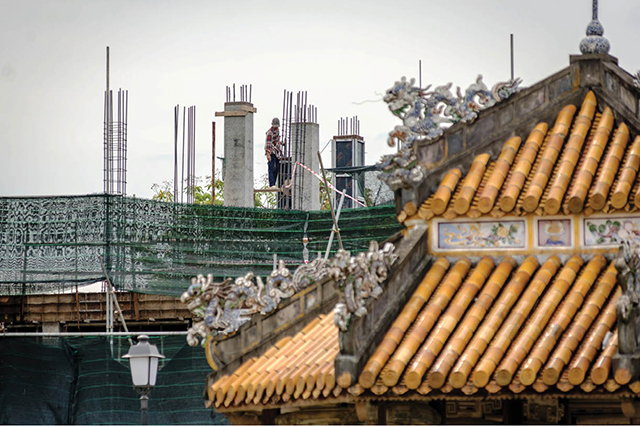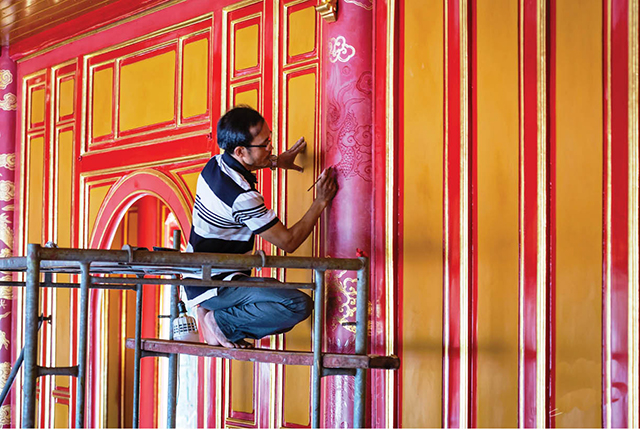
Ca Hue (Hue Singing) - Hue's typical intangible heritage
Urban heritage shape
The heritage city only stops at the conceptual level, the Law on Cultural Heritage as well as the urban regulations in Vietnam have no set of criteria, although in Vietnam not only Hue is mentioned as the city of heritage.
According to Assoc. Prof. Dr. Dang Van Bai, Vice Chairman of the Vietnam Association of Cultural Heritage, urban heritage will be made up of parts such as environment, landscape, and natural resources adapted and exploited by humans to create the artificial environment which is the city and residential areas; initial planning ideas identifying human attitudes and adaptability to nature and new ideas in the process of adjusting urban planning, urban architecture fund; lifestyles, customs and traditions, which are important intangible cultural heritage making up the cultural nuances of urban areas.

Renovating Kien Trung Palace - Hue Citadel
When the concept of heritage urbanism appears, preserving and promoting cultural heritage values must follow a new trend: they must be placed in a close relationship with the landscape, structures and spaces that constitute one complete urban area.
Through the process of thorough research from realities, the provincial government has identified 5 urban criteria with specific characteristics of unique culture and heritage. They are historical roles and heritage factors in urban functions; quantity and scale of heritage and relics; traditional elements in urban areas; the role of heritage in urban economic development; heritage management and conservation.
Considering these criteria, Deputy Secretary of the Provincial Party Committee, Chairman of the Provincial People's Committee, Head of the delegation of National Assembly of the province Phan Ngoc Tho said that Thua Thien Hue is a city with specific characteristics of unique culture and heritage with high score gained.
Besides the typical architecture of the imperial structures and tombs, Hue also preserves the traditional architecture of ruong houses and garden houses. Thua Thien Hue urban area shows a harmonious and poetic combination between human factors, architecture and natural landscape of the Huong river and Mount Ngu Binh.
In addition to the 7 world heritage sites recognized by UNESCO, Thua Thien Hue also has 2 special national monuments and more than 500 festivals, 88 craft villages. Thua Thien Hue urban area preserves many intangible cultural values such as Hue Singing, cultural festivals, folk festivals, religious festivals, gastronomy, costumes, etc.
Also according to Chairman Phan Ngoc Tho, heritage also plays an important role in the economy of Thua Thien Hue. The province has established a specialized agency in charge of heritage conservation since 1982 and organized the implementation of the plan on heritage and relic conservation which has been approved by the Prime Minister.

Restoring and renovating the drawings and gold-gilding of the dragons on the pillars of Ngu Phung Pavilion.
Building a specific mechanism aims to protect and promote the unique values of the ancient capital heritage. Hue has a foundation and strengths from the history, however, in addition to conservation, it is necessary to create a more connection between cultural heritage and tourism.
“There is no denying that Hue has made efforts to embellish, restore and preserve the heritage, but in order to do business , it is necessary to develop tourism. The central government should have a specific mechanism for the conservation of special national monuments including those of Hue,” Prof. Dr. Truong Quoc Binh, Member of the National Cultural Heritage Council said.
Opening up a new direction
In 2009, at Conclusion 48-KL/TW of the Politburo, by 2020, Thua Thien Hue will have become a city directly under the Central Government, but now it is still a dream of both the government and the people of the ancient capital.
In addition to the achievements, at the meeting between the Politburo and the Standing Committee of the Provincial Party Committee on the review of 10-year implementation of Conclusion 48-KL/ TW, in the evaluation report presented by Deputy Head of the Central Economy Department Nguyen Hong Son, the Deputy Head clarified that Thua Thien Hue has not developed to match its potentials and advantages; the economic scale has been still small; the urban system develops slowly; there has been a lack of synchronous infrastructure; the goal of building Thua Thien Hue into a municipal city under Central Government has not yet achieved.
The Politburo has issued Resolution 54, confirming the orientation towards building the goal of making Thua Thien Hue become a municipal city directly under the Central Government. After many seminars and meetings, the Politburo members affirmed that if the current set of criteria for recognizing the city under central government for Thua Thien Hue is no longer appropriate, Hue needs to build a fundamental urban model of preserving and promoting the values of the ancient capital's heritage and Hue cultural identity.
The heritage nature of Hue is the Capital of the Nguyen Dynasty, but Hue is also the earliest city in Vietnam following the Western urban architectural features, which creates a unique urban area.
Many experts and economists believe that Hue City urban area should be developed into the core zone of Thua Thien Hue heritage urban in the future; improving the efficiency of tourism activities; exploiting effectively Tam Giang lagoon, Cau Hai lagoon; developing smart urban services…; giving close attention to the preservation of intangible culture and natural landscapes. These factors play an important role in creating a "planning axis" that determines the formation and development of Hue urban heritage in the past, present and future.
At the workshop on constructing Thua Thien Hue until 2030, with a vision to 2045, Prof. Dr. Truong Quoc Binh, Member of the National Cultural Heritage Council said: “From the foundations and values of Hue, it is necessary to build and implement specific mechanisms for activities to protect and promote heritage values; research and implement strategies for economic exploitation from the heritage; encourage the implementation of a public-private partnership model to exploit the value of heritage towards sustainable development, but it is necessary to distinguish clearly between heritage exploitation and State management of the heritage”.
According to the director of the Department of Culture and Sports - Phan Thanh Hai, the process of building Hue heritage urban area will include many different types of heritage. However, the focus is on the Complex of Hue ancient capital associated with the Huong River, from upstream to the city center, extending to Bao Vinh ancient town.
“Both the government and the people need to strictly abide by the State's regulations on cultural heritage conservation; gather resources on restoration of key works and architectures; for those that are difficult to recover, the signboard will be set up to introduce the destination; carry out inventory, digitize, and make scientific records for the intangible cultural heritage system to both preserve and promote their values. In addition, we will continue to work on building records of Hue Singing and Hue culinary heritage in order to submit to UNESCO to be recognized as the intangible heritage representing humanity, etc. All those things are to make Thua Thien Hue a special heritage municipal city directly under the Central Government,” said Mr. Hai.
Story: Le Tho – Photos: Dang Tuyen